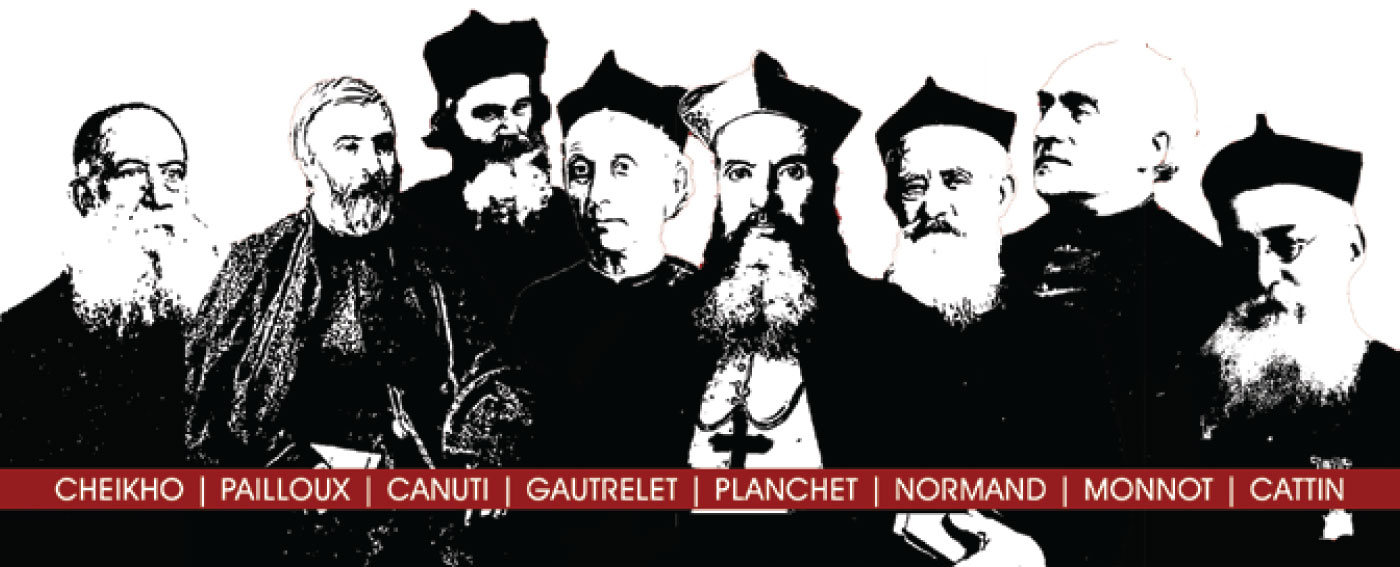Founding Fathers

As the 150th anniversary of the Saint Joseph University of Beirut (USJ) approaches, let’s reflect on the Jesuit origins that have shaped our institution. Over the past century and a half, our history has been marked by numerous legendary figures and notable personalities. Though identifying the primary founders may pose a challenge for our university community, the 150th anniversary of USJ serves as a poignant reminder to look toward the future while embracing our origins. Undoubtably, it is difficult yet crucial to honor the Founding Fathers, a courageous group of missionaries, alongside many others, who selflessly sacrificed for USJ and Lebanon. Let us, therefore, trace the paths of these visionary founders who contributed to the creation and excellence of USJ.
In his 1984 publication on the Jesuits in the Middle East, Father Henri Jalabert, a French scholar, sheds light on the extensive presence of thousands of religious individuals who have either worked or resided in the region. He acknowledged the enduring commitment of the Jesuits to the Orient by paying tribute to earlier Jesuit endeavors, notably the establishment of institutions such as the Seminary of Antoura and the Maronite College in Rome.
Father Maximilien Ryllo, a Polish Jesuit, initiated the Jesuit mission in Mount Lebanon in 1831 (Ain-Traz), which led to the establishment of the Saint Joseph University of Beirut in 1875. This period of fifty years witnessed the successful development and expansion of Jesuit missions in Syria, Egypt (1879), and Armenia (1881).
The history of USJ originates from the relocation of the Jesuit seminary-college in Ghazir to the coastal region at the end of the 19th century, a narrative deeply entwined with the Saint Francis Xavier Oriental Seminary, founded in Ghazir in 1843. Father Benoit Planchet, a French Jesuit, collaborated with Italian Fathers Louis Canuti and Boniface Soragna in founding and managing the school in Ghazir, despite interconfessional wars in Mount Lebanon in 1840 and again in 1860. The Seminary’s influence was so significant that many secular families sought enrollment for their children.
Father François-Xavier Gautrelet, a visionary French Jesuit who served as the superior of the Mission in 1864, sought to counter the recent success of American Protestant missionaries who had inaugurated a significant educational institution, featuring a medical school, in Beirut. Understanding the importance of securing funding, Father Gautrelet looked to the United States of America, where Father Ambroise Monnot, also French, embarked on a fundraising journey between June 1871 and May 1872. This journey, extensively covered in the American press, proved remarkably successful. By 1875, the necessary funds were secured, allowing for the purchase of land and the commencement of an ambitious construction project based on the designs of Father François-Xavier Pailloux, the architect behind the impressive edifice of the Saint Joseph University in Achrafieh. In October 1875, students from Ghazir were invited to inaugurate the new buildings in Beirut, and on February 25, 1881, His Holiness Pope Leo XIII granted the University authorities the right to award academic degrees, including the prestigious Doctorate in Philosophy and Theology.
The Ottoman librarian, Father Louis Cheikho, an Oriental Jesuit from Mardin, was renowned as the “Sultan of the Arabic language” for his remarkable efforts in expanding and preserving the collections of books and manuscripts, which had been added to collections initially amassed by Swiss Father Alexandre Bourquenoud in 1857 in Ghazir. Father Cheikho dedicated over a quarter of a century to safeguarding the premises and the collections, especially during the tumultuous periods of World War I (1914-1918) and the Great Famine. Moreover, in 1898, he founded the renowned journal Al-Machriq. Following this, in 1905, French Father Henri Gressien initiated the expansion of the Oriental Library premises. The international reputation of USJ in archaeological and geographical studies owes much to the systematic exploration in the mountains of Lebanon and Syria conducted by Father Michel Jullien and Father Godefroy Zummofen, both from France and Switzerland, respectively. No ancient Syrian monument escaped the meticulous studies of Father Henri Lammens from Belgium and Father Sébastien Ronzevalle from France, whose works were widely published in Europe. Furthermore, the contributions of French Father René Mouterde and the aerial archaeology photographs captured by Father Antoine Poidebard, also from France, emerged as indispensable scientific references in the field.
Father Remi Normand, French Superior of the Mission in Syria, laid the groundwork for missions in Egypt and Armenia. Through discussions and negotiations with Léon Gambetta and Jules Ferry, he secured initial funding that led to the opening of a medical school in Beirut in November 1883, initially enrolling 11 students, a number which grew to 355 by 1914. Subsequently, this institution evolved into the Faculty of Medicine in 1888. Its remarkable success and reputation not only enhanced the educational landscape but also reflected the growth and prosperity of Beirut. It became the administrative and political capital of an Ottoman vilayet and also formed the “Ottoman Port Company”, complete with significant docks and warehouses.
In Beirut, the Faculty of Medicine flourished on Damascus Road under the guidance of Chancellor Father Lucien Cattin, a Swiss visionary. Father Cattin not only initiated the project for the sanctuary of Our Lady of Lebanon in Harissa in 1904, but also played a pivotal role in constructing the Hôtel-Dieu de France hospital in 1913. Then, in 1920, French Father Gérard de Martimprey, who had tirelessly aided the starving people of Mount Lebanon during the Great War, founded the Faculty of Dental Medicine in Beirut.
In 1906, the University sought to establish an Observatory, and after two years of careful study of the complex terrain in the Bekaa Valley, it successfully founded an astronomical observatory. It was initiated by the French Father Bonaventure Berloty, who chose the Ksara vineyard as the site. In 1912, a wireless telegraphy station (T.S.F.) was inaugurated there, but it soon became a source of concern for the Ottoman authorities in 1914, who suspected Father Berloty of collaborating with France. The Observatory was completely looted during the Great War but was later entirely rebuilt once tranquility returned.
The legacy of USJ’s Founding Fathers remains incomplete without acknowledging the monumental contributions of Father Claudius Chanteur from France, and Professor of law, Paul Huvelin, whose name adorn the Social Sciences Campus. Through their visionary pursuit of moral upliftment, Lebanon took a significant step towards justice and equality in 1913 with the establishment of the Faculty of Law. Additionally, they paved the way for a French School of Engineering in Beirut, later expanded in 1919 and 1926. Today, the renowned School of Engineering of Beirut (ESIB) stands as a testament to their legacy.
During the tumultuous years of World War II, spanning from 1938 to 1945, Father Jacques Bonnet-Eymard from France, serving as Rector, guided USJ through the challenges of frequent bombings. He initiated the construction of Collège Notre Dame de Jamhour, which became a cornerstone of Jesuit education in Lebanon.
In the shadow of the Lebanese Civil War (1975 to 1990), Father Jean Ducruet from France, Chancellor of the Faculties of Law, Economics, and Business Administration and Management, assumed the role of Rector from 1975 to 1995. His leadership endured the war’s most harrowing trials, including bombings, occupations, and assassinations. Yet, amidst these tribulations, he led the charge in formulating a University Charter, laying the groundwork for the institution’s unity and modern structure.
In 1978, Lebanese Father Sélim Abou became the Dean of the Faculty of Humanities, an institution he helped establish. Subsequently, from 1995 to 2003, he served as Rector, filling the void left by the closure of the School of Literature, a branch of Université de Lyon. Father Abou also led the University Press (PUSJ) and held the esteemed Louis D. Chair of Intercultural Anthropology at the Institut de France. His active involvement in politics and unwavering advocacy for Lebanese sovereignty distinguished him as a prominent “independentist” figure during the period from 2000 and 2005.
From 2003 to 2012, Father René Chamussy from France confronted a turbulent period in Lebanon, marked by political and security turmoil. This era saw the assassination of Rafic Hariri in 2005, Israeli aggression in July 2006, and bloody clashes in May 2008, alongside other political assassinations and bombings. As the founder of Opération 7e jour and the visionary behind the Innovation and Sports Campus (CIS), Father Chamussy broadened the University’s horizons by establishing a branch in Dubai. Throughout, he maintained internal stability at USJ amid violent protests that threatened to fracture the nation.
Since 2012, Father Salim Daccache, SJ, from Lebanon, serving as Rector of USJ, has made an enduring impact securing numerous accreditations for USJ and its faculties, establishing the Fondation USJ for fundraising, and overseeing the inauguration of various new buildings, including the “Maison de L’Ancien”. Additionally, he has built an impressive global network of partnerships and agreements to serve the University. Above all, he has led the creation of USJ Alumni Offices. His tenure has been tragically yet courageously marked by immense challenges, including the economic crisis and the collapse of Lebanese banks in 2019, the coronavirus pandemic, and the devastating Beirut port explosion in 2020.
Christian Taoutel
Curator of USJ Archives


 EN
EN FR
FR